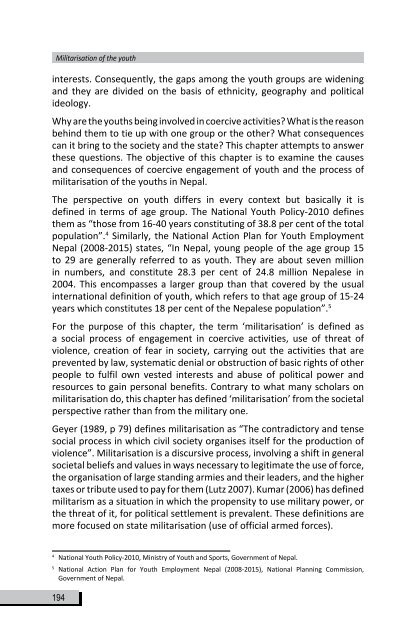English - Support to Participatory Constitution Building in Nepal ...
English - Support to Participatory Constitution Building in Nepal ...
English - Support to Participatory Constitution Building in Nepal ...
You also want an ePaper? Increase the reach of your titles
YUMPU automatically turns print PDFs into web optimized ePapers that Google loves.
Militarisation of the youth<strong>in</strong>terests. Consequently, the gaps among the youth groups are widen<strong>in</strong>gand they are divided on the basis of ethnicity, geography and politicalideology.Why are the youths be<strong>in</strong>g <strong>in</strong>volved <strong>in</strong> coercive activities? What is the reasonbeh<strong>in</strong>d them <strong>to</strong> tie up with one group or the other? What consequencescan it br<strong>in</strong>g <strong>to</strong> the society and the state? This chapter attempts <strong>to</strong> answerthese questions. The objective of this chapter is <strong>to</strong> exam<strong>in</strong>e the causesand consequences of coercive engagement of youth and the process ofmilitarisation of the youths <strong>in</strong> <strong>Nepal</strong>.The perspective on youth differs <strong>in</strong> every context but basically it isdef<strong>in</strong>ed <strong>in</strong> terms of age group. The National Youth Policy-2010 def<strong>in</strong>esthem as “those from 16-40 years constitut<strong>in</strong>g of 38.8 per cent of the <strong>to</strong>talpopulation”. 4 Similarly, the National Action Plan for Youth Employment<strong>Nepal</strong> (2008-2015) states, “In <strong>Nepal</strong>, young people of the age group 15<strong>to</strong> 29 are generally referred <strong>to</strong> as youth. They are about seven million<strong>in</strong> numbers, and constitute 28.3 per cent of 24.8 million <strong>Nepal</strong>ese <strong>in</strong>2004. This encompasses a larger group than that covered by the usual<strong>in</strong>ternational def<strong>in</strong>ition of youth, which refers <strong>to</strong> that age group of 15-24years which constitutes 18 per cent of the <strong>Nepal</strong>ese population”. 5For the purpose of this chapter, the term ‘militarisation’ is def<strong>in</strong>ed asa social process of engagement <strong>in</strong> coercive activities, use of threat ofviolence, creation of fear <strong>in</strong> society, carry<strong>in</strong>g out the activities that areprevented by law, systematic denial or obstruction of basic rights of otherpeople <strong>to</strong> fulfil own vested <strong>in</strong>terests and abuse of political power andresources <strong>to</strong> ga<strong>in</strong> personal benefits. Contrary <strong>to</strong> what many scholars onmilitarisation do, this chapter has def<strong>in</strong>ed ‘militarisation’ from the societalperspective rather than from the military one.Geyer (1989, p 79) def<strong>in</strong>es militarisation as “The contradic<strong>to</strong>ry and tensesocial process <strong>in</strong> which civil society organises itself for the production ofviolence”. Militarisation is a discursive process, <strong>in</strong>volv<strong>in</strong>g a shift <strong>in</strong> generalsocietal beliefs and values <strong>in</strong> ways necessary <strong>to</strong> legitimate the use of force,the organisation of large stand<strong>in</strong>g armies and their leaders, and the highertaxes or tribute used <strong>to</strong> pay for them (Lutz 2007). Kumar (2006) has def<strong>in</strong>edmilitarism as a situation <strong>in</strong> which the propensity <strong>to</strong> use military power, orthe threat of it, for political settlement is prevalent. These def<strong>in</strong>itions aremore focused on state militarisation (use of official armed forces).4National Youth Policy-2010, M<strong>in</strong>istry of Youth and Sports, Government of <strong>Nepal</strong>.5National Action Plan for Youth Employment <strong>Nepal</strong> (2008-2015), National Plann<strong>in</strong>g Commission,Government of <strong>Nepal</strong>.194







![g]k fnsf blntx? / gofF ;+l jwfg](https://img.yumpu.com/49483602/1/184x260/gk-fnsf-blntx-goff-l-jwfg.jpg?quality=85)



![+ljwfg;ef, /fHosf]k'g](https://img.yumpu.com/41604075/1/184x260/-ljwfgef-fhosfkg.jpg?quality=85)




